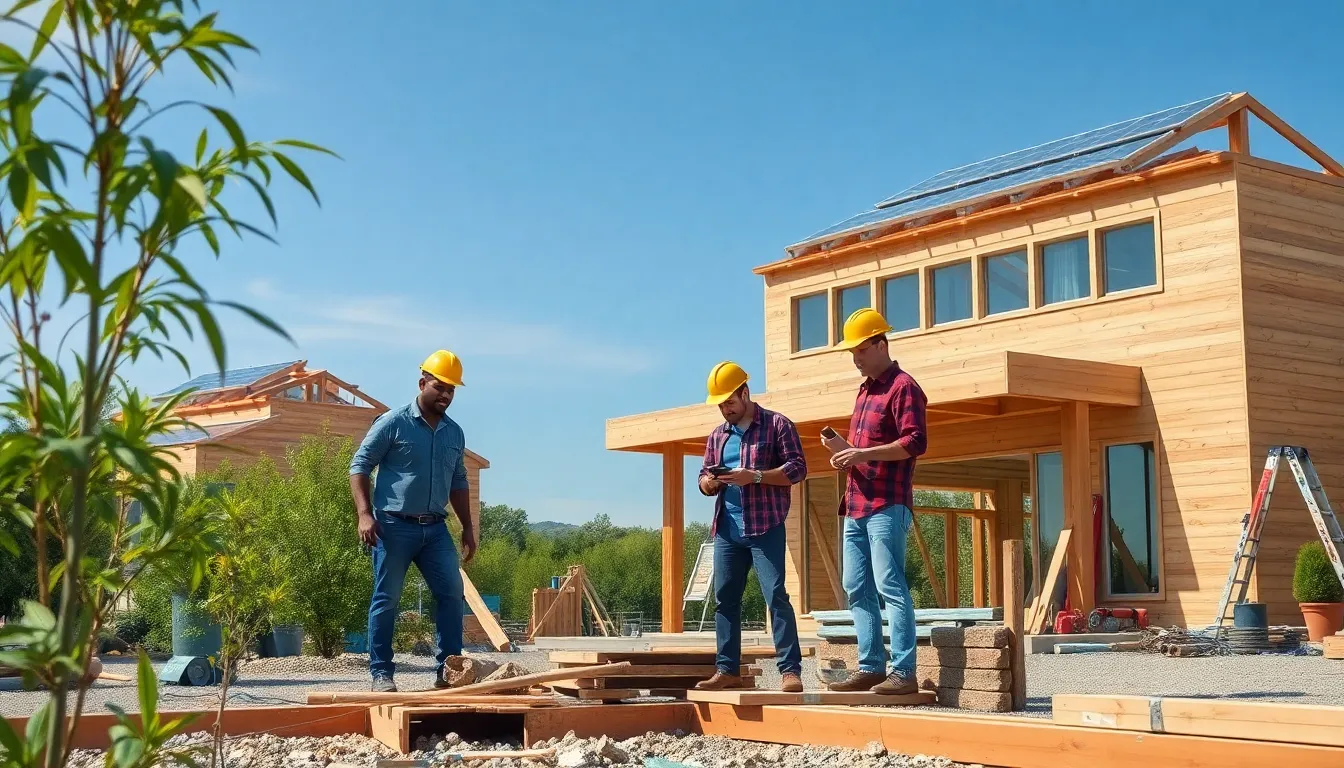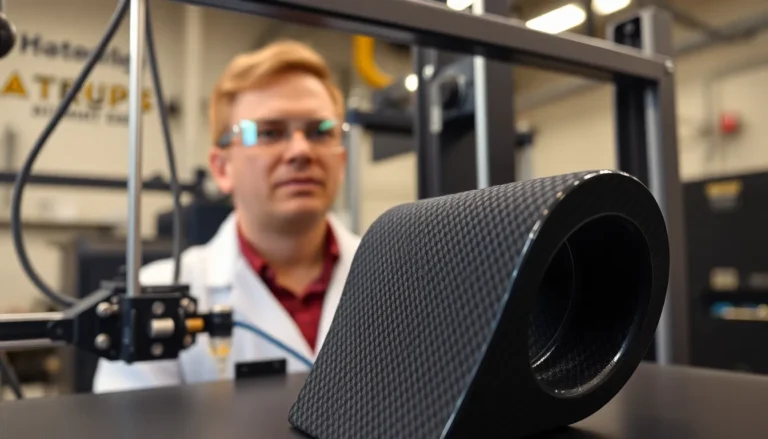Table of Contents
ToggleIn a world where Mother Nature is raising her eyebrows at humanity’s antics, green building technology swoops in like a superhero with a cape made of recycled materials. It’s not just about saving the planet; it’s about creating spaces that are as smart as they are sustainable. Imagine living in a home that not only looks good but also knows how to hug a tree—or at least not chop it down.
As the construction industry evolves, eco-friendly practices are becoming the norm rather than the exception. From energy-efficient designs to innovative materials that make your grandma’s house look like a relic, green building technology is here to stay. So why not join the movement that’s as stylish as it is responsible? After all, who wouldn’t want to live in a building that’s doing its part to save the Earth while keeping energy bills low?
Overview of Green Building Technology
Green building technology focuses on sustainability in construction and design. This approach reduces environmental impact through efficient resource use and eco-friendly materials. Innovations in green building include energy-efficient systems, sustainable materials, and smarter designs that lessen waste.
Energy-efficient features often incorporate solar panels and high-performance insulation. They lower energy consumption and reduce utility costs. Water conservation techniques, such as rainwater harvesting and efficient plumbing fixtures, minimize water use and help preserve local environments.
Sustainable materials, like bamboo and recycled steel, enhance building durability while lowering carbon footprints. These environmentally friendly choices support the recycling economy and promote responsible sourcing. Green roofing systems also improve energy efficiency and provide natural habitats for wildlife.
Design strategies for green buildings emphasize natural light and ventilation. These features create healthier living spaces. By reducing reliance on artificial lighting and HVAC systems, buildings maintain optimal indoor air quality.
Leading certification programs, including LEED (Leadership in Energy and Environmental Design) and BREEAM (Building Research Establishment Environmental Assessment Method), assess and recognize green building practices. These certifications validate the commitment to sustainability and help guide builders and owners in their projects.
Green building technology represents a significant shift in industry practices. It embraces the principles of sustainability while delivering functional, aesthetically appealing spaces. As this movement gains momentum, the construction industry moves towards a more responsible and environmentally focused future.
Key Components of Green Building Technology

Green building technology incorporates various elements aimed at enhancing sustainability and minimizing environmental impact. This section explores the essential components that contribute to eco-friendly construction.
Sustainable Materials
Sustainable materials are key to reducing a building’s carbon footprint. Bamboo offers rapid renewability and strength. Recycled steel provides durability while decreasing resource extraction. Utilizing reclaimed wood reduces waste and adds character to spaces. Recycled glass integrates beauty with functionality. Manufacturers are increasingly focused on sourcing materials locally, which lowers transportation emissions and supports local economies. Overall, selecting these sustainable materials promotes a healthier planet and aligns with green building principles.
Energy Efficiency
Energy efficiency is critical for minimizing energy consumption in buildings. Incorporating solar panels drastically lowers reliance on non-renewable energy sources. High-performance insulation prevents heat loss, leading to lower heating and cooling costs. Smart thermostats optimize energy use by adjusting based on occupancy. Energy-efficient windows help maintain indoor comfort while reducing energy expenses. Implementing energy-efficient lighting solutions reduces electricity consumption significantly. Each of these measures contributes to a sustainable lifestyle while ensuring long-term savings.
Water Conservation
Water conservation techniques play a vital role in green building technology. Rainwater harvesting systems capture and store rainwater for various uses, lessening demand on municipal supplies. Low-flow fixtures minimize water usage in bathrooms and kitchens significantly. Native landscaping requires less irrigation, promoting local biodiversity. Greywater systems recycle water from sinks and showers for irrigation or toilet flushing. Implementing these water-saving strategies reduces overall consumption and helps protect local water resources.
Benefits of Green Building Technology
Green building technology offers numerous benefits that significantly contribute to sustainable practices in construction and design. These advantages span environmental, economic, and health aspects, promoting a more responsible approach to living and working spaces.
Environmental Impact
Green building technology drastically reduces environmental impact. By utilizing sustainable materials and efficient resource management, it limits waste generation and lowers carbon emissions. Energy-efficient systems, such as solar panels, help decrease reliance on fossil fuels. Moreover, water conservation techniques protect local water supplies by minimizing consumption and encouraging the use of rainwater harvesting systems. Biodiversity benefits from landscaping practices designed to enhance local ecosystems. Overall, these practices combine to support a healthier planet.
Economic Advantages
Economic advantages of green building technology manifest in various ways. Investing in energy-efficient systems often leads to significant cost savings on utility bills. Property values increase for sustainable buildings, as buyers increasingly prioritize eco-friendly features. Many governments offer incentives, such as tax breaks or grants, for adopting green practices, enhancing affordability. Over time, lower maintenance costs result from the durability of eco-friendly materials. The long-term benefits create a compelling case for businesses and homeowners alike.
Health Benefits
Health benefits associated with green building technology contribute to improved well-being. Natural light and ventilation reduce dependency on artificial lighting and heating systems, fostering a more pleasant living environment. Poor indoor air quality often relates to traditional building materials that emit harmful substances; green buildings mitigate this risk through the use of non-toxic materials. Additionally, access to green spaces encourages physical activity and mental well-being. By prioritizing health through innovative designs, green buildings create healthier, happier communities.
Challenges in Implementing Green Building Technology
Implementing green building technology faces multiple challenges that can hinder progress.
Cost Considerations
Costs associated with green building technology often deter developers and investors. Initial expenses for sustainable materials and energy-efficient systems can exceed traditional construction costs. However, long-term savings on utility bills may offset these upfront investments. Many projects require specialized training for workers, which adds to overall expenditures. Financial incentives and grants from government agencies can ease the burden of high initial costs, encouraging more developers to consider sustainable options.
Regulatory Hurdles
Regulatory hurdles further complicate the adoption of green building technology. Zoning laws and building codes sometimes do not accommodate innovative materials or designs that promote sustainability. Some regions lack up-to-date regulations that recognize green practices, making it difficult for builders to comply with local requirements. Additional time spent navigating extensive permitting processes can delay project timelines. Collaborating with local authorities and advocacy groups can streamline approvals and encourage the integration of green building standards.
Future Trends in Green Building Technology
Emerging trends in green building technology shape the future of sustainable construction. Innovations like modular construction enhance efficiency, allowing for quicker assembly and reduced waste. Prefabrication processes contribute significantly by minimizing on-site disruptions and improving quality control.
Smart building technology is set to revolutionize energy management. Integration of IoT devices enables real-time monitoring of energy consumption. These devices optimize energy use, providing analytics that help in further reducing costs and environmental impact.
Sustainable urban design trends also gain momentum. Green roofs and vertical gardens improve air quality and provide natural insulation. Incorporating these elements into urban areas offers aesthetic benefits while promoting biodiversity.
Advancements in renewable energy sources continue to gain attention. Wind turbines and solar technologies are increasingly common features in new buildings. These technologies allow structures to produce their own energy, achieving net-zero energy consumption.
Further, biophilic design will play an essential role in future developments. This approach emphasizes natural elements within built environments, reducing stress and improving well-being. Enhanced connections to nature cater to occupant health and productivity.
Policy changes are likely to accelerate these trends. Governments increasingly incentivize green building practices through tax rebates and funding programs. This push makes it easier for developers to adopt innovative technologies and practices.
Consumer demand for sustainable living spaces continues to rise. Buyers increasingly prioritize eco-friendly features when selecting properties. Emphasis on energy efficiency and sustainable materials influences purchasing decisions significantly.
These future trends highlight a commitment to more sustainable, responsible building practices.
Green building technology stands as a transformative force in the construction industry. By prioritizing sustainability and energy efficiency, it addresses pressing environmental challenges while enhancing quality of life. The shift towards eco-friendly materials and innovative design not only reduces carbon footprints but also fosters healthier living environments.
As trends evolve and consumer demand for sustainable options grows, the future of green building looks promising. Overcoming initial cost barriers and regulatory challenges will require collaboration among stakeholders. Ultimately, embracing green building technology paves the way for a more sustainable and responsible approach to construction, benefiting both people and the planet.




